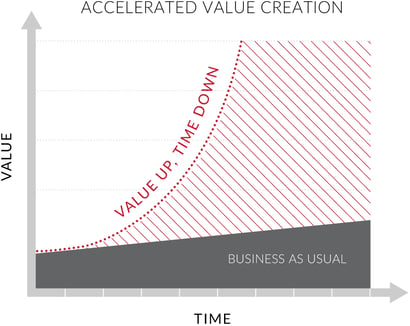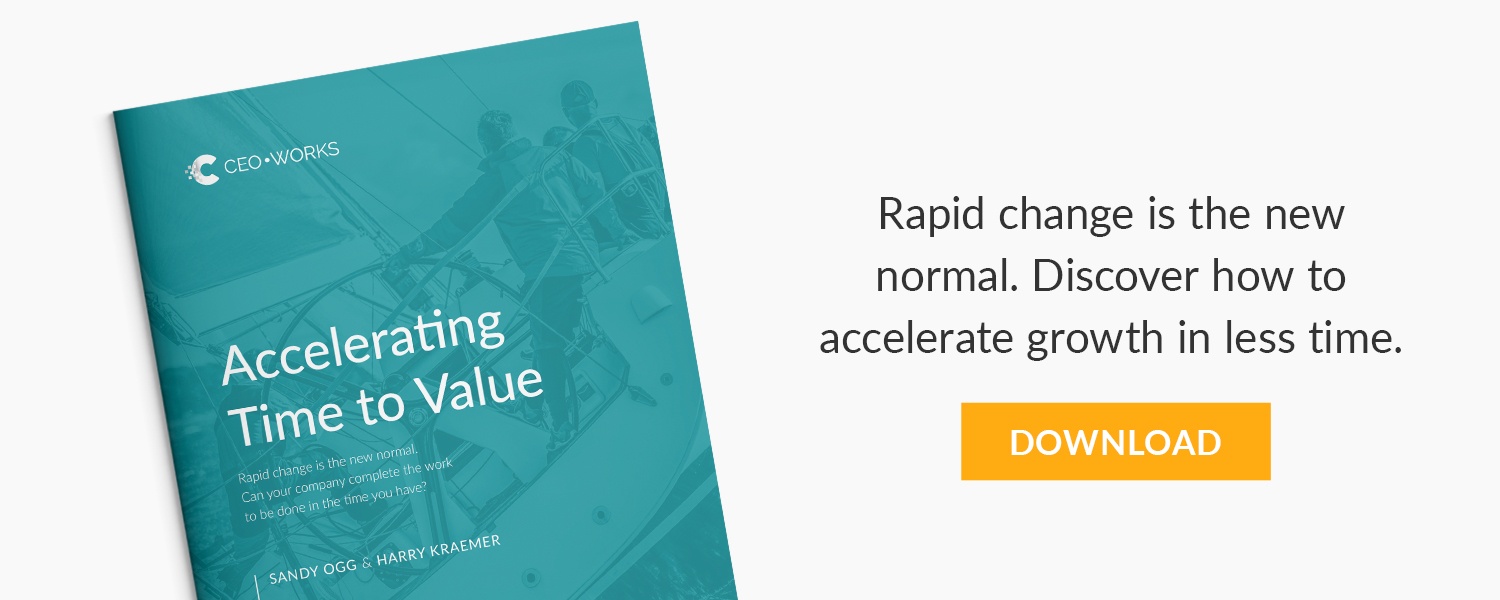By Sandy Ogg and Harry Kraemer Jr.
The significant uncertainty and chaos created by COVID-19 have dramatically impacted the global economy. Even before the virus hit, CEOs were more pessimistic and less confident about the future revenues of their companies than even a mere two years ago. We believe the wisest business response involves anticipating what will be valued tomorrow—and reducing the time it takes to deliver that value at speed.
Your natural response as a CEO to such an urgent leadership imperative might be to think big, start big and move fast by launching new initiatives. This will create some forward momentum. However, adding lots of new work on top of old and then asking people to run even faster inevitably creates chaos, slows everything down, and ultimately, puts you on the firing line (literally). It doesn’t matter that your whole enterprise is incredibly focused on creating value. The organization—and you—simply run out of time.
The 4 Time Traps
 Too many CEOs and their leadership teams fail at accelerating value creation. We advise them to think bigger about the amount of value they want their company to generate, bearing in mind where value is shifting, and to be brutally honest about the time they will have to realize their value agenda. (The less time it takes them, the less it will cost to finance and the higher the return). Reflection reveals the challenge their organization will inevitably face: a mountain of “new” work to change and grow the business on top of all the “old” work necessary to keep it running.
Too many CEOs and their leadership teams fail at accelerating value creation. We advise them to think bigger about the amount of value they want their company to generate, bearing in mind where value is shifting, and to be brutally honest about the time they will have to realize their value agenda. (The less time it takes them, the less it will cost to finance and the higher the return). Reflection reveals the challenge their organization will inevitably face: a mountain of “new” work to change and grow the business on top of all the “old” work necessary to keep it running.
To generate speed, we encourage them to start smaller by moving money and redeploying talent to their value hotspots, those places in the organization where huge upticks in value creation are or will be occurring. To enforce an exponential “value up, time down” bend in their company’s value curve, we also strongly recommend they move faster by proactively managing the following 4 time traps commonly found in organizations.
1. Stakeholder Alignment
A new value agenda declares to everyone both inside and outside the company what you as CEO think winning will look like. It sets up the scoring system for executing the “new strategy”. Ideally, it will reflect your company’s history, purpose and fundamental strengths.
Clearly communicating this new value agenda and all the “new” work it will require to all the company’s stakeholders—from the internal leadership team and employees to suppliers and distributors, business partners and communities—won’t automatically ensure everyone will be on board. During discussions with each stakeholder group about what is to be done, when and how much it will cost, you may sense some resistance. Such friction acts like a tax. It literally slows down work and takes time to resolve.
This time trap can be minimized by proactively gaining sufficient alignment among key stakeholder groups on the new value agenda, decision rights and operating cadence.
2. Capability Gaps
Stakeholders are sufficiently aligned with the what, when and how much of your company’s new value agenda. Now the question is whether your company can do all of the necessary work or not. New work usually calls for new capabilities—from capital assets and tools to systems, processes and talent—which inevitably take time and money to build.
While all capability gaps are important to address, talent gaps can be critical. Without people, it doesn’t matter if you have all the required resources ready at a value hotspot: nothing will get done. For example, say your education company’s biggest value hotspot is in China. You need 10 bricks-and-mortar schools filled with students there, but you don’t have anyone in the country with enough experience and knowledge about how to build these facilities in East Asia. You will have to either redeploy and/or hire talented individuals who have the capabilities to navigate the Chinese political system, obtain the right approvals and permits, oversee the actual construction of the facilities, and enroll parents in registering their children in the new schools. Without this critical talent on hand, any time and money spent on building other capabilities at this value hotspot may be going into a black hole.
The Talent to Value process can help you quickly close critical talent gaps at value hotspots and minimize the effects of this time trap.
3. Culture Clash
The culture of your company and its business ecosystem should work with your value agenda—not against it. However, you will likely be asking people to do things in new ways, ways that conflict with how they have done things in the past.
This disruption of old habits will show up, once again, in the form of resistance that slows down execution. Dealing with this friction will generate more extra work. A prime example of this would be a company with a U.S.-centric focus trying to go global. Siloism and finger-pointing, old traditions of isolation and blame, will clash with their new ambition. These traditions will have to be replaced with new ones, such as shared accountability for results and collaboration across regions. The fastest way to introduce them into the culture? Start with the standards of behavior of the company’s leaders.
This time trap can be averted by identifying the select few behaviors that are trapping value and time in your organization and then changing them from the top down.
4. Capacity Shortfall
The true capacity of any company can only be accessed if everyone is “working wiser”.
That is, working on what matters most to the value agenda.
Many leaders get deceived into thinking that what matters most is just the “new” work associated with creating value. But we have found that the real capacity killer is the accumulation of work to be done at the time traps, including: garnering and maintaining sufficient stakeholder alignment, addressing resistance, building necessary capabilities, and recalibrating leadership behaviors. The trouble is most organizations do too much. The antidote? Design an effective plan to deliver value over time that ranks and appropriately sequences this critical work.
We agree with the statement that, “Although organizational activity is often either dismissed as status quo or overlooked, it can be managed to create value.”1 More and more we are seeing the need for leaders to courageously focus their organization on just a few potent Time•Value Initiatives—the fewest number of initiatives possible to deliver the value agenda—and discard the rest (for now). Some Time•Value Initiatives will be transformational; others will be income-generating. Some will reduce costs; others will increase revenues in ways that allow for more flow-through of profits. By selecting the work of highest value that really needs to be done and sequencing it to deliver value over time, the company can accomplish more by truly thinking bigger, starting smaller and moving faster.
1Jens Jahn, Thomas Rasmussen, and Reinhard Messenböck. “Unlocking Change Management with People Analytics”. Boston Consulting Group, June 2019. Accessed January 20, 2020 at https://www.bcg.com/en-ca/publications/2019/change-management-with-people-analytics.aspx.


